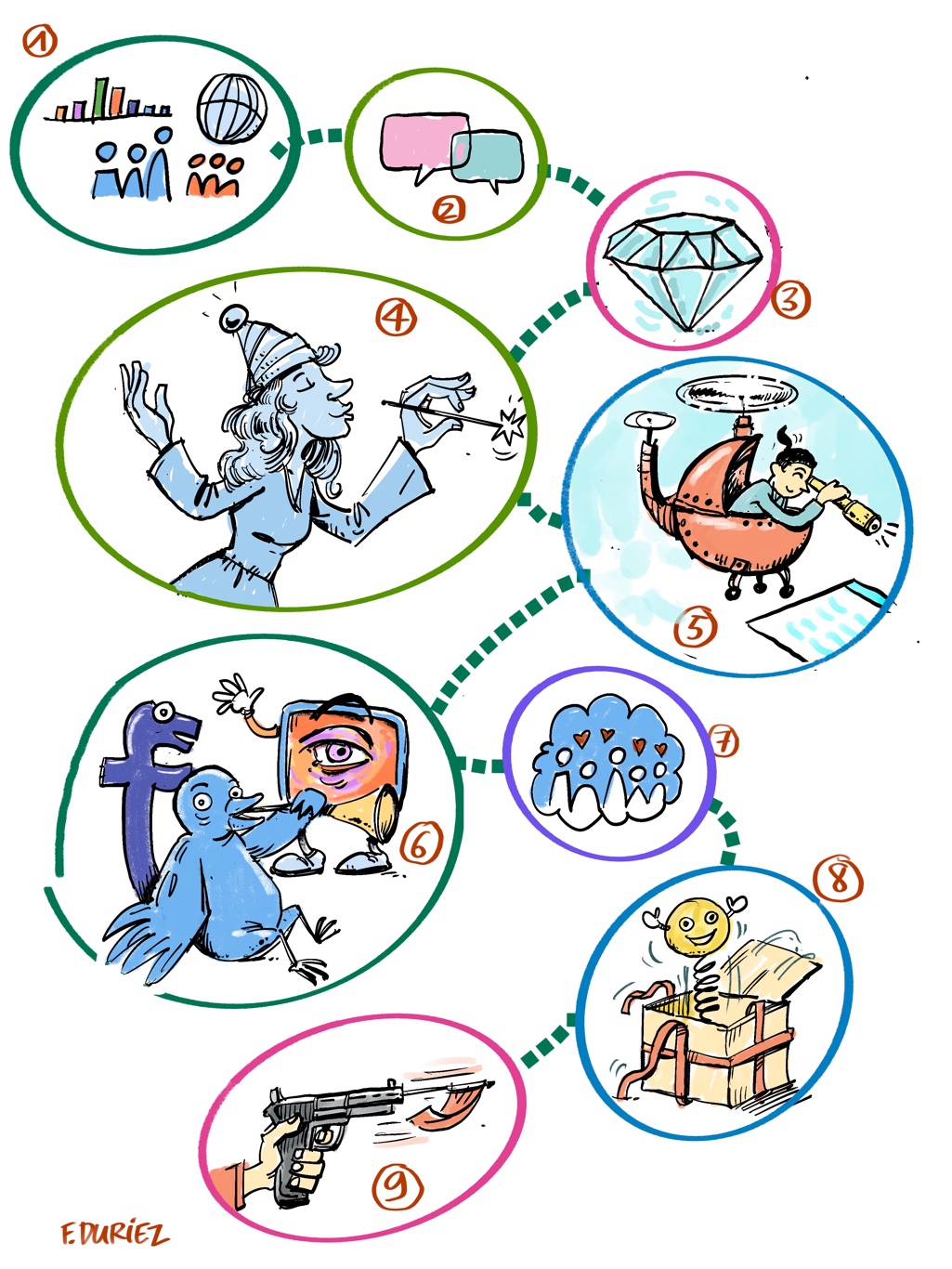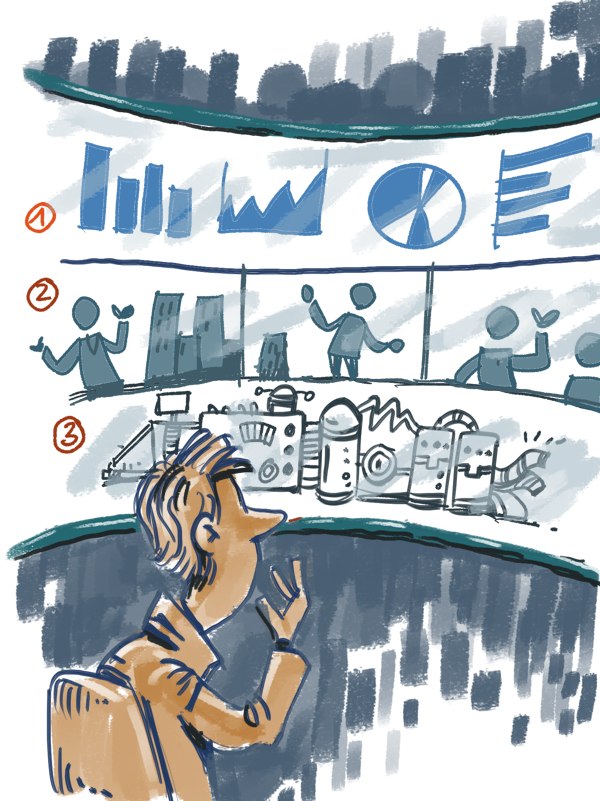How to create an economic activity and live from its creations when the barriers to entry accumulate? Finding a publisher, a distribution circuit, convincing intermediaries to associate their efforts with yours seem to be so many insurmountable activities. An economic model that is built on the relationship, storytelling techniques and participation is now available to designers.
We no longer have the desire or the energy to consume and the cupboards are full
You want to sell a cultural product, a book, a film or music. It’s going to be complicated: no one has space on their shelves anymore. The fashion is for emptiness and storage. In this case, should files or access to platforms be sold rather than objects? It is a solution, but few are those who access this mode of distribution. The actors are few, they think in tens of millions of euros or dollars. Difficult for beginners to find a place.
The difficulty does not end there. Consuming and buying are no longer a dream. On the contrary, our appetites are fading and sobriety does not spare cultural assets. Libraries, forums for discussion, online consultations or loans are all solutions to stop accumulating objects, while taking advantage of cultural goods. If you buy, it’s because you didn’t understand anything. The desire to possess is so twentieth century!
No doubt the platforms that offer to have anything delivered in a few hours have also contributed to killing desire. Immediately wanted, immediately delivered, consumed and forgotten. Desire is linked to waiting, it takes time, it must be able to settle. It is not of the same nature as impulse buying.
Awaken the desire
Crowdfunding takes the opposite view of platforms that deliver within a quarter of an hour. They invite you to get involved before the project is completed. At best, you’ve seen prototypes. Often, it’s the first pages of a book, two songs or even three minutes of film. We wait a few months to receive our compensation. Extracts, information, presentations of the work in progress keep us attentive.
But we didn’t buy anything. We contributed to a project. We are not customers of a finished product, but promoters of a project or a concept. There is also a part of betting in this adventure. If there aren’t enough of us, then the project will die out, with nothing in return. Crowdfunding therefore sends a very different image of itself to the buyer. It allows an adventure, it accompanies a project, it launches itself into a collective financing action.
At the crossroads of narratives
Crowdfunding is built on storytelling marketing. First of all, there is this suspense on my “reward”, which may be attributed to me, but whose nature sometimes evolves with the project.
There is also uncertainty about funding. Are we going to reach the goal? Will we exceed it and unlock additional bonuses?
A third story, more distant and undoubtedly essential, concerns the story of the project leaders.
Thus, Mad Magazine was published in the United States between the 1950s and the beginning of the 2020s. While publishing stopped, a few authors launched publications in the spirit of the magazine of the 70s, with parodies, precise caricatures and humorous dialogues.
The authors tell us a story of a return to basics, the story of a new economic model, and the story of a project that is being built and where contributors can influence the choices of parodied films.
Whatever the project, it is necessary to tell the story of its birth, the story of its financing and the story of its implementation. You have to tell, as you would tell a fiction, by creating suspense, by involving and hooking the audience!
A few steps in a collaborative financing process
In a detailed article, the English blog Peer to peer marketing invites us to discover the recipes of a crowdfunding operation. So many stages of a game of goose presented below, where each box deserves to be clarified in turn!
- The authors invite us to create a audience. Who are you talking to? What do they look like, what are their needs, their expectations, their geographical location and their habits? Pretty standard marketing. But because on the Internet we sometimes have the illusion of being able to address everyone, we sometimes forget to specify our audience.
- Then you have to engage interactions, dialogue and exchanges. Not “likes” or impressions but more engaging actions that show real interest. It’s about creating a community. “Crowdfunding is not fundraising. It’s making something happen with a crowd of people who believe in something”, says Jozefiens Daelemans quoted by Peer to peer marketing.
- Build the trust with his audience is the third step. We need transparency, authenticity. Successful project promoters bring humanity and sincerity. Pellichi, who publishes comics about her profession as a researcher, shares her doubts with us.
- Develop a history, a universe, which gives a little magic and a surplus of added value to what the person buys.
- Work the home page on which Internet users will “land”. This page towards which the other media converge is the one on which a large part of the transformation depends, between interest and engagement. It must be alive, take up the codes, the arguments, the tone of the other media and supports.
- Social media accounts should converge towards a common vision. There is a good chance that the person who follows you on Twitter is also subscribed to the Instagram account. Using the specificities of each of the networks, not giving exactly the same story on each will encourage membership. A nuanced repetition, with a few surprises sometimes, and always the feeling that we are accessing new elements.
- Animate the community, promote the relationship and the share of emotion. Let us remember that the participants above all share values, a vision and a project. They carry out a common action, and it deserves to be encouraged!
Crowdfunding is not just collecting money, it’s causing something with people who believe in something (Jozefien Daelermans – quoted in peertopeermarketing) - To propose surprises, unexpected rewards and that make sense. We can for example print the name of the donors on the back cover of the book or inside or even become a character of the work, for the most generous. This practice existed a few centuries ago when the donors found themselves among the saints or the angels of a painting in a church. Nothing new. Dedications, originals, additional products are also common rewards. If the relationship is important in engaging contributors, a meet-and-greet or hand-delivery of rewards might make sense.
- Maintain attention on the project time by bringing it into an “attention economy” This last point is not essential in the short term, since the participants who have committed can receive their reward after a few months, without doing anything and when they have forgotten gave something!

These steps and tips are not valid for all projects. They shift the competitive field into a different space of shelves, impulse buys, or three-click decisions. They take the opposite view of companies that make speed of delivery an essential asset.
They also allow participants to discover the creators, to familiarize themselves with what is happening behind the scenes and sometimes even to act as mentors by encouraging the teams.
Illustrations: Frédéric Duriez
Resources
Peer-to-peer marketing – article: crowdfunding marketing consulted on September 17, 2022
https://peertopeermarketing.co/crowdfunding-marketing/
Kisskissbankbank – Company website
https://www.kisskissbankbank.com/
Crowdfunding directory – Thot Cursus
See more articles by this author
We wish to thank the writer of this article for this incredible content
I don’t buy, I contribute to an adventure
Find here our social media profiles , as well as other related pageshttps://nimblespirit.com/related-pages/

